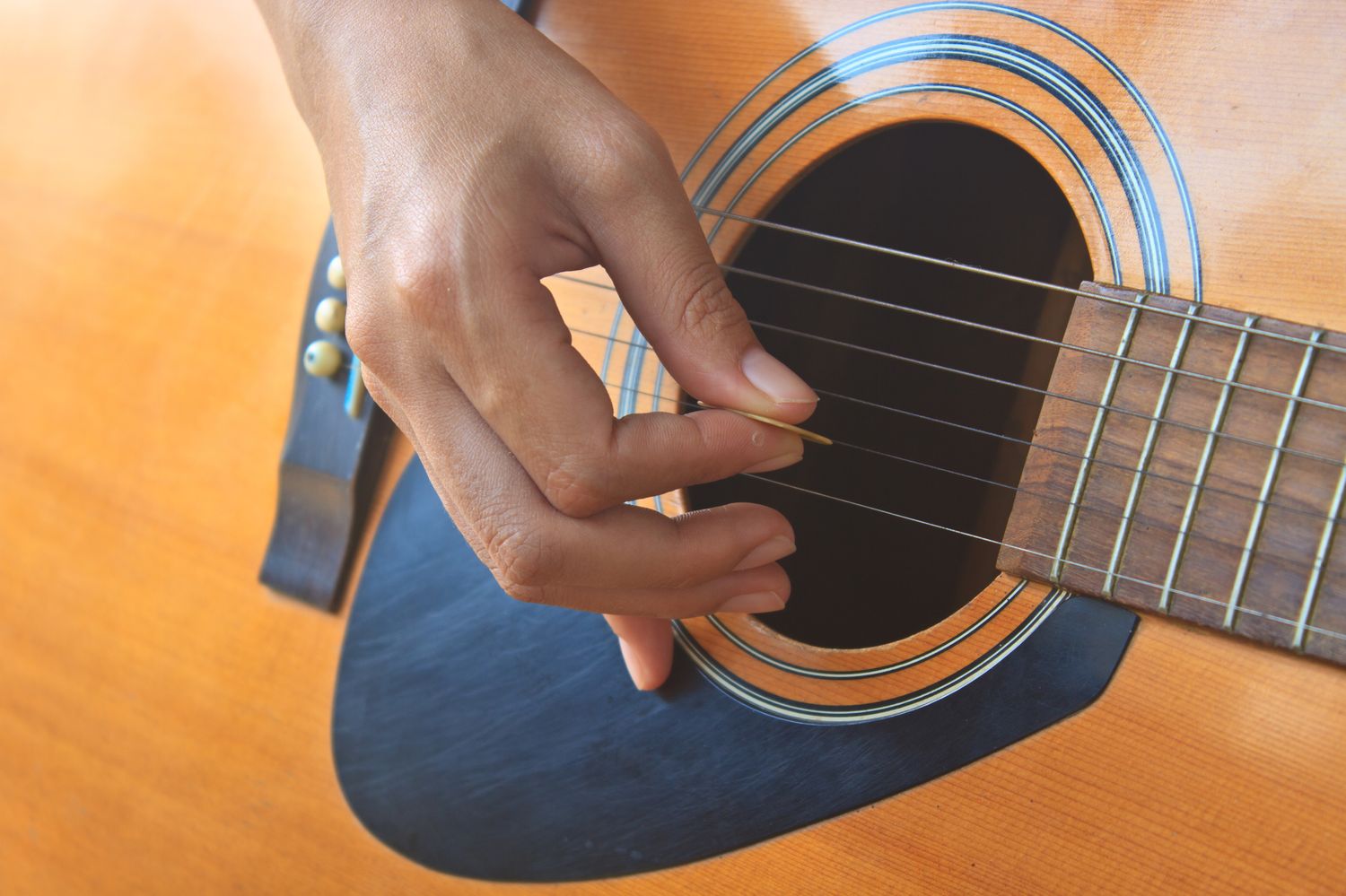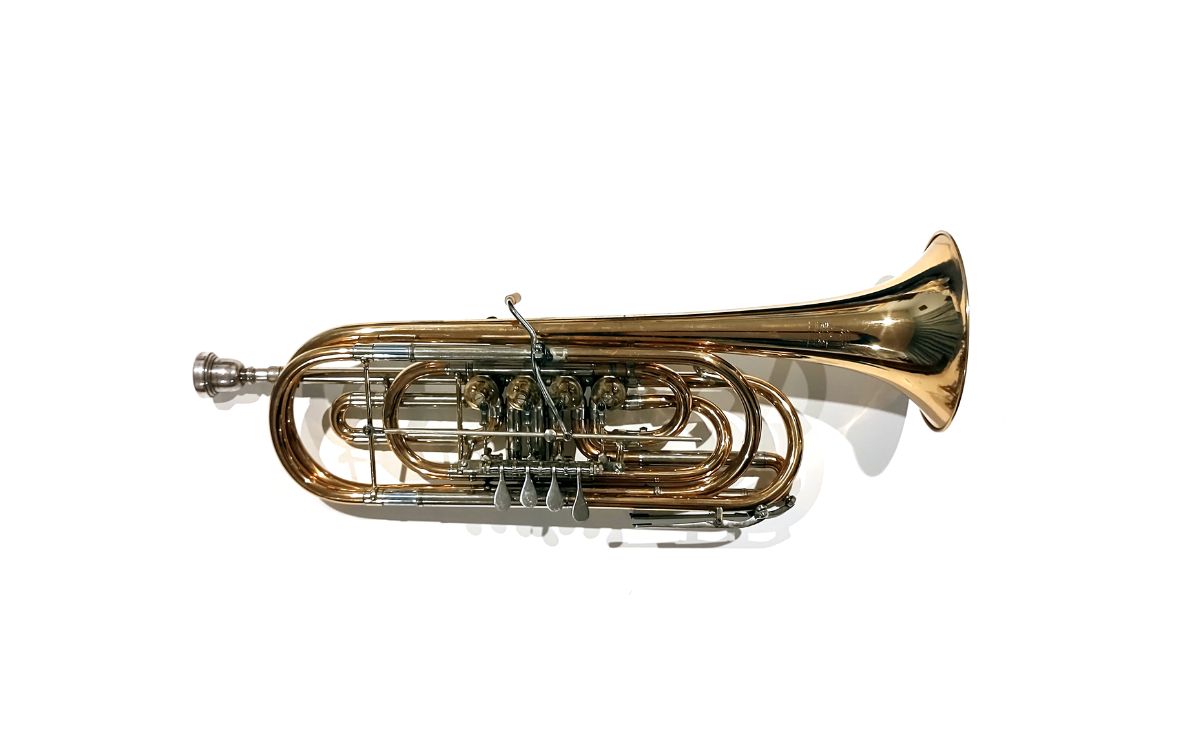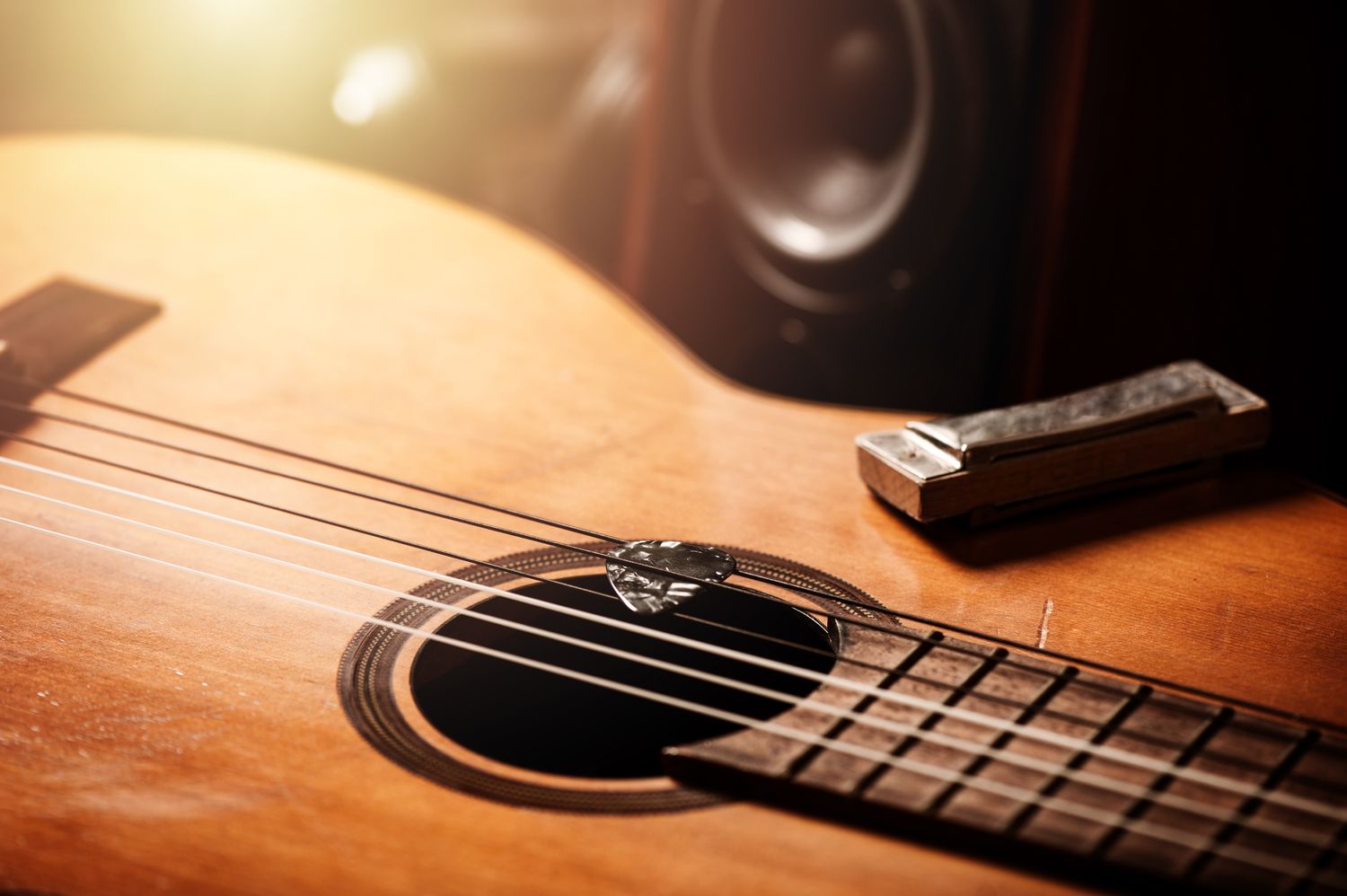Home>Instruments>Bass>How To Use A Pick On Bass


Bass
How To Use A Pick On Bass
Modified: January 22, 2024
Learn how to effectively use a pick on bass with these expert tips and techniques. Enhance your bass playing skills and achieve a powerful sound.
(Many of the links in this article redirect to a specific reviewed product. Your purchase of these products through affiliate links helps to generate commission for AudioLover.com, at no extra cost. Learn more)
Table of Contents
Introduction
When it comes to playing the bass guitar, there are various techniques and tools that can help you achieve the desired tone and sound. One such tool that often sparks debate among bassists is the use of a pick. While many bass players prefer to use their fingers to pluck the strings, using a pick can offer a unique and distinct sound that might be just what you’re looking for.
A pick, also known as a plectrum, is a small flat tool typically made of plastic, nylon, or metal. It is held between the thumb and index finger and used to strike or pluck the strings of the bass guitar. While picks are commonly associated with playing the guitar, they can also be used effectively on the bass to achieve a more aggressive, punchy, and defined tone.
So, why would you want to use a pick on bass? The answer lies in the sound. Using a pick can provide a brighter and more attacking tone compared to using your fingers. It can also help you achieve a consistent and precise attack, especially when playing faster passages or complex rhythms. Additionally, using a pick can give your bass playing a unique flavor, allowing you to stand out in a band or recording mix.
However, it’s important to note that using a pick on bass is a matter of personal preference. Some bassists prefer the warmth and control they can get with their fingers, while others enjoy the sharpness and aggressiveness a pick offers. Ultimately, it’s up to you to decide which technique best suits your playing style and the sound you want to achieve.
In this article, we will explore the various aspects of using a pick on bass. We will discuss how to choose the right pick, the proper holding and grip technique, and the strumming and picking techniques that will help you get the most out of using a pick on your bass guitar. We will also cover common mistakes to avoid and provide exercises to improve your pick technique. By the end of this article, you’ll have a better understanding of how to incorporate a pick into your bass playing and how it can enhance your overall sound and musical expression. Let’s dive in!
What is a pick?
A pick, also known as a plectrum, is a small, flat tool used to strike or pluck the strings of a bass guitar. It is typically made of plastic, nylon, or metal and is held between the thumb and index finger.
Picks come in various shapes, sizes, and thicknesses, each producing a different sound and offering a different playing experience. Thin picks produce a brighter and twangier sound, while thicker picks result in a heavier and more defined tone. The choice of pick will depend on your personal preference and the sound you’re aiming for.
Plastic picks are the most commonly used type, as they offer flexibility, durability, and a wide range of options. Nylon picks, on the other hand, have a smoother surface, allowing for faster picking and a more controlled attack. Metal picks, usually made of steel or brass, provide a metallic and aggressive sound.
Aside from the material, picks also feature different shapes. The most common shape is the traditional teardrop shape, which allows for a comfortable grip and versatile playing. Jazz picks, also known as small triangles, have a pointed tip and shorter length, making them ideal for fast and precise playing. There are also specialty picks with unique shapes, such as shark fins or thumb picks, designed for specific playing styles or techniques.
The choice of pick will depend on factors such as the genre of music you play, your playing style, and personal preference. It’s a good idea to experiment with different picks to find the one that feels comfortable in your hand and produces the desired sound.
Now that you know what a pick is and the different types available, let’s move on to the reasons why you might consider using a pick on a bass guitar.
Why use a pick on bass?
Using a pick on bass can offer a range of benefits and enhance your playing in several ways. Here are a few reasons why you might consider using a pick:
- Tone: Using a pick can provide a brighter and more aggressive tone compared to using your fingers. It can add clarity and definition to your playing, especially when playing fast or complex passages. The pick’s attack on the strings can create a sharper and punchier sound, which may be desirable in certain musical genres or for specific song arrangements.
- Consistency: One of the challenges of playing bass with your fingers is achieving consistent dynamics and attack. Using a pick can help you achieve smooth and even note articulation, as the pick strikes the strings with a consistent force. This can be particularly useful when playing intricate bass lines that require precise and controlled picking.
- Speed and Agility: The use of a pick can allow for faster and more agile playing, especially when it comes to playing more intricate and rapid passages. The solid contact between the pick and the strings facilitates quick and precise movements, making it easier to navigate through complex bass lines or perform fast-paced rhythm sections.
- Distinct Sound: Using a pick on bass can help you create a unique sound and stand out in a band or mix. It can add a different texture and character to your playing, allowing you to explore new sonic possibilities and add variety to your musical repertoire.
- Expanded Playing Techniques: While fingerstyle playing is versatile and expressive, using a pick opens up additional playing techniques and possibilities. For example, you can incorporate strumming patterns and techniques commonly used in guitar playing, such as palm-muted strumming or chunky power chords. This can add a different dimension to your bass playing and enable you to explore a wider range of musical styles.
While using a pick on bass has its advantages, it’s important to note that it’s not a requirement or a superior technique. Bassists have different preferences and styles, and some may prefer using their fingers to achieve a warmer and more nuanced tone. The choice between using a pick or fingers ultimately depends on your personal preference, the musical context, and the sound you want to achieve.
Now that you have an understanding of why using a pick on bass can be beneficial, let’s delve into the process of choosing the right pick for your playing style.
Choosing the right pick
Choosing the right pick for your bass playing is crucial to achieving the desired sound and feel. With so many options available, it’s important to consider factors such as material, thickness, shape, and texture. Here are some things to keep in mind when selecting a pick:
- Material: Picks can be made of various materials, including plastic, nylon, and metal. Each material produces a distinct tone and feel. Plastic picks are the most common and versatile, offering flexibility and a wide range of options. Nylon picks have a smoother surface, allowing for faster picking with a more controlled attack. Metal picks provide a brighter, metallic sound and are ideal for rock and heavy metal genres.
- Thickness: The thickness of the pick affects both the tone and the playing experience. Thin picks produce a brighter and snappier sound, ideal for genres like pop, funk, or R&B. Thicker picks result in a heavier and more defined tone, suitable for rock, metal, or aggressive playing. It’s worth experimenting with different thicknesses to find the one that feels comfortable and produces the desired sound for your playing style.
- Shape: Picks are available in various shapes, including teardrop, jazz, and specialty shapes. The teardrop shape is the most common and versatile, providing a comfortable grip and allowing for versatile playing techniques. Jazz picks, with their pointed tip and shorter length, are ideal for fast and intricate playing. Specialty picks, such as thumb picks or shark fins, are designed for specific techniques or playing styles. Consider the shape that feels most comfortable in your hand and facilitates your playing style.
- Texture: The texture of the pick’s surface can impact your grip and playing experience. Smooth picks allow for quick gliding and slick playing, while picks with textured or rough surfaces provide better grip and control. Consider your playing style and whether you prefer a smooth or textured surface to determine the best pick for you.
- Personal preference: Ultimately, choosing the right pick is a matter of personal preference. What feels comfortable and natural in your hand, and what produces the desired tone for your bass playing? Experiment with different picks and listen to how they affect your sound. Keep in mind that your preferences may change over time, so don’t hesitate to explore new options and revisit your pick selection periodically.
Remember, there is no one-size-fits-all solution when it comes to selecting a pick. Your choice should be based on your musical style, your playing technique, and your personal preferences. Take the time to try out different picks and consider their impact on your tone and playing dynamics. This experimentation will help you find the perfect pick that complements your playing style and brings out the best in your bass guitar.
Now that you have chosen the right pick, it’s time to learn the proper holding and grip technique for optimal performance.
Proper holding and grip technique
The way you hold and grip the pick is crucial for achieving control, accuracy, and comfort while playing bass. Here are some tips for developing a proper holding and grip technique:
- Holding the pick: Hold the pick between the thumb and index finger using a relaxed grip. It’s important not to grip the pick too tightly as it can hinder your ability to produce a fluid motion. Aim for a firm but comfortable hold that allows the pick to move smoothly across the strings.
- Thumb placement: Position your thumb on the side of the pick, with the tip protruding slightly over the top. This will provide stability and control as you strike the strings. Avoid gripping the pick too close to the tip or too far back towards the middle, as it can affect your accuracy and control.
- Index finger placement: Place your index finger on the back of the pick, opposite your thumb. The pad of your finger should make contact with the pick, helping to stabilize it and prevent it from slipping. Keep your index finger slightly curved, allowing for flexibility and precise control of the pick.
- Angle of attack: Experiment with different angles of attack to find the one that works best for you. Some bassists prefer a nearly parallel angle, while others prefer a slight angle towards the bass strings. Find the angle that allows for smooth movement across the strings while maintaining a consistent tone and attack.
- Hand position: Your hand position should be relaxed and natural, with your wrist and forearm aligned in a straight line. Avoid excessive tension in your hand and forearm, as it can lead to fatigue and inhibit your playing ability. Allow for fluid movement and flexibility in your hand position.
- Alternate picking: Practice alternate picking to develop speed and accuracy. Alternate picking involves consistently alternating between downstrokes and upstrokes with the pick. This technique enables you to play faster passages and intricate rhythms more efficiently. Start with slow, controlled exercises and gradually increase the speed as your technique improves.
Remember, developing a proper holding and grip technique takes time and practice. Be patient with yourself as you explore different hand positions and find what feels most comfortable and allows for optimal control. Regular practice and focused attention on your grip technique will help you refine your skills and improve your bass playing.
Now that you have mastered the holding and grip technique, it’s time to dive into the strumming and picking techniques that will bring your bass playing to the next level.
Strumming and picking technique
Once you have established the proper holding and grip technique, it’s time to delve into the various strumming and picking techniques that will enhance your bass playing. These techniques will help you achieve different rhythms, dynamics, and textures. Let’s explore some essential techniques:
- Downstrokes and upstrokes: Downstrokes involve striking the strings with a downward motion, using the pick to generate sound. Upstrokes, on the other hand, involve striking the strings in an upward motion. Practice both downstrokes and upstrokes individually to develop control and accuracy.
- Alternate picking: Alternate picking is a fundamental technique that involves alternating between downstrokes and upstrokes in a continuous motion. This technique is particularly useful for playing fast and precise bass lines. Start slowly with a metronome, gradually increasing the speed as you develop your control and coordination.
- Rest stroke: The rest stroke technique involves allowing the pick to rest against the next string after striking it. This technique helps to produce a clear and defined sound while preventing the pick from accidentally hitting other strings. Experiment with incorporating rest strokes into your playing to enhance your articulation and control.
- String skipping: String skipping involves selectively striking certain strings while bypassing others. This technique adds complexity and texture to your bass playing. Practice string skipping exercises to improve your accuracy and ability to navigate across the strings.
- Strumming: Strumming on bass is a technique borrowed from guitar playing. It involves sweeping the pick across multiple strings simultaneously to produce a chord-like effect. Experiment with different strumming patterns and rhythms to add depth and variation to your bass lines.
- Palm muting: Palm muting is a technique where you lightly rest the side of your palm against the strings near the bridge while picking or strumming. This dampens the sound, resulting in a subdued and percussive tone. Palm muting can be used to create a tight and rhythmic feel, especially in genres like rock, punk, or metal.
- Hybrid picking: Hybrid picking combines the use of a pick and fingers. It involves using the pick for some notes and using your fingers (usually the middle and ring fingers) to pluck others. This technique provides added dexterity and versatility, allowing for more intricate and dynamic bass playing.
Remember to start slow and focus on accuracy and control when practicing these techniques. Use a metronome to maintain a steady tempo and gradually increase the speed as you become more comfortable. Regular practice and deliberate attention to your picking and strumming technique will lead to improvements in your bass playing.
Now that you have learned essential strumming and picking techniques, it’s important to be aware of common mistakes to avoid. Let’s explore those in the next section.
Common mistakes to avoid
While learning to use a pick on bass, it’s important to be aware of common mistakes that can hinder your progress and hinder your ability to achieve optimal results. By recognizing and avoiding these pitfalls, you can improve your overall technique and enhance your bass playing. Here are some common mistakes to watch out for:
- Gripping the pick too tightly: Holding the pick with excessive tension can restrict your flexibility and hinder your ability to strike the strings with fluidity. Aim for a firm but relaxed grip that allows for freedom of movement and flexibility in your picking technique.
- Not maintaining consistent picking dynamics: Consistency in picking dynamics is crucial for achieving a balanced and controlled sound. Avoid unintentionally accenting certain notes or strings by applying inconsistent power or speed with your picking hand. Practice with a metronome and focus on maintaining a steady and consistent attack on the strings.
- Overusing string skipping: While string skipping can add complexity and texture to your playing, it’s important to use it judiciously. Overusing string skipping can result in a cluttered and confusing sound. Instead, focus on utilizing it strategically to emphasize certain notes or create interesting melodic patterns.
- Not experimenting with pick thickness: The thickness of the pick affects both the tone and the playing experience. Don’t be afraid to experiment with picks of different thicknesses to find the one that suits your playing style and produces the desired sound. It’s often a matter of personal preference and finding the right balance for your specific needs.
- Failing to incorporate finger techniques: While using a pick can provide a unique and distinct sound, don’t disregard the versatility and expressiveness of fingerstyle playing. Incorporating finger techniques alongside your pick playing can add depth and nuance to your bass lines. Experiment with combining finger plucking, popping, or tapping with your pick technique to expand your musical capabilities.
- Ignoring hand and wrist positioning: Improper hand and wrist positioning can lead to discomfort, tension, and even injury. Ensure that your hand is relaxed and your wrist is aligned with your forearm. Avoid excessive tension and practice good ergonomic habits to prevent strain and promote long-term playing health.
By being mindful of these common mistakes and actively working to avoid them, you can develop a solid foundation in your pick technique and improve your overall bass playing. Regular practice, focused attention, and a willingness to experiment with different approaches will ultimately lead to greater proficiency and musical expression.
Now, let’s examine the benefits and drawbacks of using a pick on bass to help you make an informed decision about incorporating it into your playing style.
Benefits and drawbacks of using a pick on bass
Using a pick on bass offers several benefits and drawbacks that you should consider when deciding whether to incorporate it into your playing style. Understanding these pros and cons will help you make an informed decision about whether using a pick aligns with your musical goals and preferences. Let’s explore the benefits and drawbacks below:
- Benefits:
- Drawbacks:
- Downstroke/Upstroke Alternation: Practice alternating between downstrokes and upstrokes in a continuous motion. Start slowly with a metronome and increase the speed over time. Focus on maintaining a steady tempo and consistent tone while transitioning between strokes smoothly.
- String-Skipping Patterns: Develop your string-skipping abilities by practicing exercises that involve selectively striking certain strings while skipping others. Start with basic patterns and gradually increase the complexity. This exercise improves your ability to navigate the bass strings with accuracy and control.
- Pick Slurs: Practice executing smooth and articulate slides with your pick. Start with a downstroke and slide the pick up or down the string smoothly and evenly until the desired note is reached. Focus on maintaining a consistent tone and avoiding any sudden jumps in volume or the clarity of the note.
- Speed Building: Set a metronome to a comfortable tempo and practice playing short, repetitive phrases or scales at that speed with a pick. Gradually increase the metronome tempo as you improve your accuracy and control. This exercise will help develop your speed, precision, and coordination with the pick.
- Palm Muting Exercises: Practice palm muting techniques with a pick to achieve a tighter and more percussive tone. Experiment with different palm placement and pressure on the strings while striking them with the pick. Focus on maintaining a consistent muted sound and controlling the level of sustain.
- Dynamic Control: Practice exercises that focus on varying the dynamics of your pick attack. Start by playing a phrase softly and gradually increase the volume and intensity with the pick while maintaining accuracy and consistency. Also, practice the reverse by starting loudly and gradually decreasing the volume to a soft passage.
– Tone: Using a pick can produce a brighter and more aggressive tone, adding clarity and definition to your bass playing. It can be particularly effective in genres that require a punchier and more pronounced sound.
– Consistency: Picks allow for more consistent dynamics and attack than fingers, making it easier to achieve even note articulation and control. This can be advantageous when playing complex bass lines or fast-paced rhythms.
– Speed and agility: Picks facilitate faster and more agile playing, enabling you to navigate through intricate bass lines with precision and ease. The solid contact between the pick and strings allows for quick and accurate movements.
– Unique sound: By using a pick, you can create a distinct sound that sets you apart in a band or recording mix. It can bring a different texture to your playing and add variety to your musical expression.
– Limited techniques: Using a pick limits you to a certain range of techniques compared to fingerstyle playing. Techniques such as slapping, popping, or tapping are more challenging with a pick, as they rely on the dexterity and direct contact of the fingers.
– Lack of warmth and nuance: While picks offer clarity and attack, they can lack the warmth and subtle nuances that fingers provide. Fingerstyle playing allows for greater control over dynamics, tone, and expression.
– Style limitations: Using a pick may not be suitable for all musical styles. Genres that require a softer, more melodic or intricate bass playing may be better suited to fingerstyle techniques.
– Less tactile connection: Using a pick can create a slight barrier between your fingers and the strings, leading to a reduced tactile connection. This can impact your ability to feel the strings and adjust your playing technique accordingly.
Ultimately, whether to use a pick on bass is a personal choice. Consider your musical genre, playing style, and the desired sound you wish to achieve. Many bassists find value in incorporating a pick into their playing, either as a primary technique or as an additional tool to expand their sonic palette. Experimentation and exploration of different techniques can help you find the right balance and enhance your bass playing.
Now, let’s explore some exercises to help you improve your pick technique and further develop your skills.
Exercises for improving pick technique
To enhance your pick technique on bass, regular practice and targeted exercises can make a significant difference. These exercises will help improve your speed, accuracy, control, and overall fluidity when using a pick. Here are some exercises to incorporate into your practice routine:
Remember to start with a slow tempo and gradually increase the speed as your technique improves. Focus on maintaining control, accuracy, and a relaxed grip throughout the exercises. Take breaks when necessary to avoid muscle tension and fatigue, and always listen to your body to prevent any potential strains or injuries.
Consistency is key when practicing these exercises. Set aside dedicated time for pick technique practice, and gradually incorporate them into your regular bass playing routine. By consistently working on these exercises, you will improve your pick technique, expand your playing capabilities, and ultimately enhance your bass playing skills.
Now, let’s conclude our exploration of using a pick on bass guitar.
Conclusion
Using a pick on bass can be a valuable tool to enhance your playing and achieve a unique sound. Whether you are a beginner exploring different techniques or an experienced bassist looking to expand your sonic palette, incorporating a pick into your playing can offer a range of benefits. It provides a brighter tone, improved consistency, increased speed and agility, and the ability to add a distinct flavor to your bass lines.
Throughout this article, we have covered the essentials of using a pick on bass. We discussed what a pick is, explored the reasons why you might want to use a pick, and provided guidance on choosing the right pick for your needs. We also emphasized the importance of proper holding and grip technique, explored various strumming and picking techniques, and highlighted common mistakes to avoid.
It’s important to remember that using a pick on bass is not a superior technique or a requirement for playing the instrument. Every bassist has their own preferences and playing style, and fingerstyle playing has its own merits and advantages. The choice between using a pick or fingers ultimately depends on your personal preference, the musical context, and the sound you want to achieve.
By practicing with dedication, incorporating targeted exercises, and constantly refining your technique, you can develop proficiency and versatility with a pick on bass. Remember to be patient with yourself and focus on gradually improving your skills over time. Regular practice and experimentation will help you find the right balance and incorporate the pick into your unique playing style.
Whether you choose to use a pick or stick with fingerstyle playing, the ultimate goal is to express yourself and create music that resonates with you. Embrace your individuality, explore different playing techniques, and most importantly, have fun on your bass playing journey.
Now, pick up your bass guitar, grab a pick, and let your music soar!











